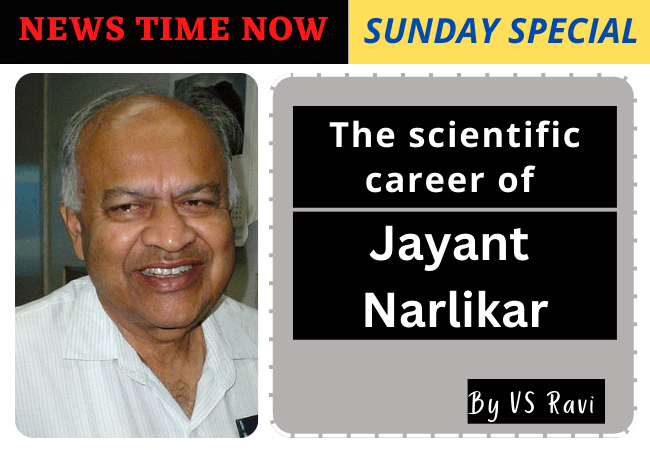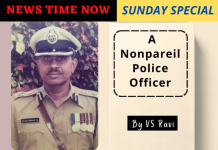Any account of the number of academic degrees and medals won, positions held and Honours and Fellowships received from prestigious Educational Institutions, in India as well as abroad by the brilliant astrophysicist Jayant Narlikar, would take up an entire page, but one cannot afford not to list them when one is wring about his life and career. He was born on July 19, 1938 in Kolhapur, Maharashtra. He received his early education in the Benares Hindu University (BHU), where his father was Professor and Head of the Mathematics Department. His mother was a Sanskrit scholar. After a brilliant performance in school, Narlikar got his B.Sc. degree at BHU in 1957. He then went to Cambridge for higher studies, becoming a Wrangler and also a Tyson Medallist in the Mathematical Tripos. He got four Cambridge degrees in his favourite subject mathematics but specialised in astronomy and astrophysics. He got two more medals at Cambridge, the Smith’s Prize in 1962 and the Adams Prize in 1967. He later stayed on at Cambridge till 1972, as Fellow of King’s College (1963-72) and Founder Staff Member of the Institute of Theoretical Astronomy (1966-72). During this period he laid the foundations of his research work in cosmology and astrophysics in collaboration with his distinguished mentor, Fred Hoyle.
Narlikar returned to India to join the Tata Institute of Fundamental Research (1972-1989) where under his charge the Theoretical Astrophysics Group expanded and acquired international standing. In 1988 the University Grants Commission invited him to set up the proposed Inter-University Centre for Astronomy and Astrophysics (IUCAA) as its Founder Director. He held the Directorship of IUCAA until his retirement in 2003.
Narlikar got married in 1966. His wife was awarded a Ph.D. in mathematics. They had three daughters, all of whom have opted for research careers in science.
Under his direction IUCAA acquired a world-wide reputation as a centre for excellence in teaching and research in astronomy and astrophysics. After retirement he was made Emeritus Professor at IUCAA.
The Universe is just space, time, matter and energy. It includes all the familiar entities like stars, galaxies, and all other versions of matter. Apart from visible matter, it is dominated by dark matter and dark energy. We don’t have the slightest clue what they are. Even though unknown factors exist, cosmologists have come up with many theories that explain the nature of our Universe.
The Big Bang Theory, postulated by LeMaitre is the most accepted scientific description of the evolution of the Universe. As per this origin theory, time and space emerged from a singularity 13.7 billion years ago. As a result of inflation, it is still expanding. Even though the physical dimension of the Universe is not known, the rate of cosmic expansion suggests that it should have a diameter of about 23 trillion light-years. Among all the theories about the evolution of the Universe, the Big Bang has the most viable postulates that are compatible with the available observational characteristics of the cosmos.
However, there are a bunch of physicists and cosmologists who are against it. The most famous theory that tries to counter the inflation postulate is the Steady-State Theory put forth by the astrophysicists Fred Hoyle, Herman Bondi, and Thomas Gold. Narlikar belongs to this group. According to them, the overall density of the Universe stays constant even if the space is expanding. This result is only possible when there is a continuous generation of matter at a very high rate. The Steady State theory got out of the hype with the discovery of the cosmic microwave background radiation, by Arno Penzius and Thomas Wilson.
Narlikar was President of the Cosmology Commission of the International Astronomical Union from 1994 to 1997. His work has been on the frontiers of gravity, Mach’s Principle, and quantum cosmology. He has also worked on problems related to quasars, black holes, etc. He received several national and international awards and honorary doctorates. He is a Bhatnagar awardee, as well as recipient of the M.P. Birla award, and an Associate of the Royal Astronomical Society of London. He is Fellow of the three national science academies as well as of the Third World Academy of Sciences. Apart from his scientific research, Narlikar has been well known as a science communicator through his books, articles, and radio/TV programmes. He is also known for his science fiction stories. For all these efforts, he was honoured by the UNESCO in 1996 with the Kalinga Award for popular science works.
Narlikar has broken new grounds in space research. Since 1999 he has been heading a multi- institutional team of scientists pioneering experiments designed to sample air at heights of up to 41 km, to look for microorganisms. Biological studies of the samples collected in 2001 and 2005 led to the findings of live cells and bacteria, thus opening out the intriguing possibility that the Earth is being bombarded by microorganisms some of which might have seeded life itself here.
Narlikar was awarded the Padma Bhushan in 1965, at the young age of 26. In 2004 he was awarded Padma Vibhushan. In 2011, the Government of the State of Maharashtra honoured him with the State’s highest civilian award of Maharashtra Bhushan. In 2014, the Sahitya Akademi, the premiere literary body in India, selected his autobiography for its highest prize in regional language (Marathi) writing.
Narlikar spoke about the desirability of students wanting to pursue a career in science to listen to scientists like Dirac, and Feynman to derive inspiration. Narlikar himself owes his inspiration to Hoyle (it does not matter that Hoyle went wrong about the Standard Steady State theory. His work on stellar nucleosynthesis is still held in high esteem).
Incidentally all scientists ( e.g. Dirac, Powell, Neils Bohr, and Gamow) who visited MATSCIENCE (the Madras Institute of Mathematical Science) founded by my uncle Ramakrishnan, a brilliant physicist) to deliver lectures, stayed at EKAMRA NIVAS, my grandfather’s house( considered a heritage house).
Though I was just a schoolboy my uncle asked me to ensure that Dirac’s stay was “comfortable”. I remember listening to Dirac, when he delivered a lecture in Ekamra Nivas the next morning. I didn’t understand 99 % of what the great man was saying, but I could feel the thrill and excitement. Later in the evening my uncle and I were chatting with Dirac and his wife just after dinner. Dirac (who was a man of very few words) suddenly retired to his bedroom upstairs; my uncle asked Dirac’s wife what Dirac usually did between dinner and actually going to sleep” – we were not obviously referring to any other activity! She said ” he thinks”. My uncle and I simultaneously asked ” what does he think about?”. She replied” He just thinks , and thinks with his eyes open” We persisted. She then clarified– “he keeps wondering whether the so called ‘ether’ actually exists or not and also about the existence of anti- matter, predicted by him theoretically. She added that of late he has been wondering whether the so called” constants” in Physics keep “changing”! “.
Narlikar was of the view that the setting up of special Laboratories e.g NPL (National Physical Laboratory) and other similar Institutes, at the time of independence in our country was a derogatory step. He opined that the accent and emphasis should have been on improving the “academic atmosphere in Universities with complete autonomy. He felt that this was how England was able to produce the finest scientists in the world in the 20th century when Cambridge and Oxford alone produced more Nobel Laureates than most other countries put together.
In America, Nobel Laureate Sheldon Glashow also made a similar plea for shifting research in Science, from laboratories to UNIVERSITIES, if they had to compete with academic centres in Europe, in general and England in particular.
There is a growing awareness, thanks to Narlikar and a few other scientists in our country that only if our Universities become centres of learning in the real sense. and not merely factories that produce ” silicon chip Indians” (a phrase coined by me – my brother who is a world famous, neuroscientist loves it) for being exported to America, or England will India be able to produce world class scientists.


















































